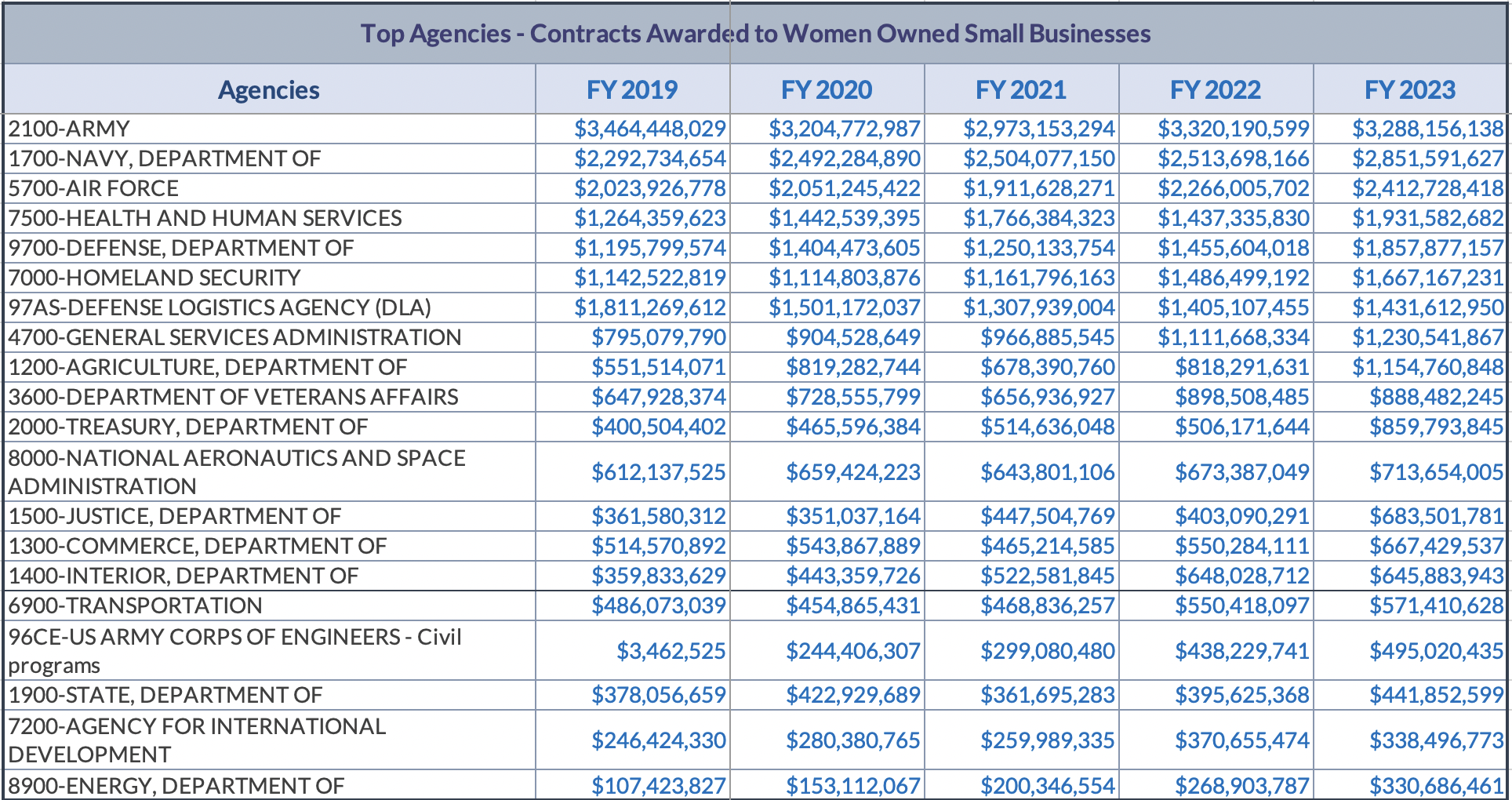
March is Women’s History Month, which means it’s a perfect time to honor and celebrate women entrepreneurs! According to the National Women’s Business Council 2023 Annual Report, 14 million women-owned businesses (WOB) make up 39% of all US businesses – a number that has grown 13.6% from 2019 to 2023. The 2022 Annual Business Survey, which covers 2021, estimates that women-owned businesses had an estimated $2.1 trillion in receipts and an estimated 10.5 million employees.
So, how did Women-Owned Small Businesses (WOSB) do in federal government contracting in FY’23? While total federal contract awards reached an all-time high of $775B in FY’23, only 3.2% or $25.49B was awarded to 13,707 women-owned businesses, falling short of the federal government’s goal of 5%. Interestingly, 1,537 of the WOSBs were first-timers winning contracts!

Over the past five years, contracts awarded to Women-Owned Small Businesses (WOSBs) have consistently hovered around 3.2% of total federal awards, or roughly $22B.
Among the agencies leading the contract awards to Women-Owned Small Businesses (WOSBs) were Department of Defense agencies, with $12.3B, representing 48% of the total contracts awarded to WOSBs. Additionally, agencies like Health & Human Services, Homeland Security, GSA, the Department of Agriculture, and the Department of Veterans Affairs were also actively awarding contracts to WOSBs.

Looking at the spend within each agency, many agencies, including HHS, DHS, GSA, and Agriculture saw an increase in their awards. However, while we look at the total dollars obligated by these agencies, it is crucial to analyze their WOSB expenditure in comparison to their total spending to gain a comprehensive understanding of the percentage of contracts they allocate to WOSBs.
When analyzing the dollars awarded to Women-Owned Small Businesses (WOSBs), it’s essential to not only focus on the overall amount but also consider the use of set-asides and sole-source awards. As illustrated in the graph, 3% of the awards were designated as WOSB Set-Asides, 0.34% as WOSB sole-source awards, and less than 0.12% as Economically Disadvantaged WOSB set-asides. Contrasting this with over 8% of contracts awarded as 8(a) sole-source and competed, as well as more than 20% that were awarded as small business set-asides, highlights the importance of paying attention to the use of set-asides to the WOSBs. Seeing a rise in the utilization of WOSB/EDWOSB set-asides and sole-source awards will serve as a clear indicator of the success of the WOSB program.

As we understand the use of the set-aside program, it is also important to understand the use of NAICS codes, specifically for set-asides and sole source awards. It’s no surprise to see computer-related, engineering, construction, and administrative services at the top of the NAICS codes for the awards to WOSB.

Among the Women-Owned Small Businesses who won the most federal contracts in FY’23 are FCN Inc., Countertrade Products Inc., Blue Tech Inc., Software Information Resource Corp, DMS Pharmaceutical, Advanced Computer Concepts, First Nation Group, Sterling Computers, AccelGov, and Axle Informatics.

Also not surprising are the states where WOSBs are winning most contracts – Virginia, Maryland, California, Florida, and Texas.

Reflecting on the data, it’s clear that Women-Owned Small Businesses still face challenges, with awards hovering around the $22B mark and only accounting for 3.2% of total federal awards. This begs the question – what steps are needed to achieve the federal government’s 5% goal for WOSBs? In FY’23, reaching a 5% goal would have meant $39B in awards, a target that, while ambitious, is certainly within reach.
As a first step, it’s imperative that both agencies and businesses are knowledgeable in the programs that are meant to award more business to women. Contracting Officers need to be well-versed and comfortable with the WOSB/EDWOSB set-aside/sole source programs, which is no small feat. At the same time, while the US Small Business Administration has implemented programs to support women-owned businesses-owned, they need additional training, mentorship, and access to capital, through programs like US SBA CapLine, to ensure that they are empowered to pursue federal contracts with confidence.
In addition, should we consider expanding the list of eligible industries, allowing more women-owned businesses to win federal tax dollars.
Personally, I witness a strong dedication to empowering our women-owned businesses in my interactions with industry and federal agencies, and I remain optimistic about the possibility of reaching the 5% goal sooner rather than later!
Note: The data is based on Fedmine’s analysis of FPDS data as of 3/18/24



